胡壮麟 语言学教程修订版 课堂笔记和讲义精选Chapter (6)
- 格式:doc
- 大小:49.00 KB
- 文档页数:6
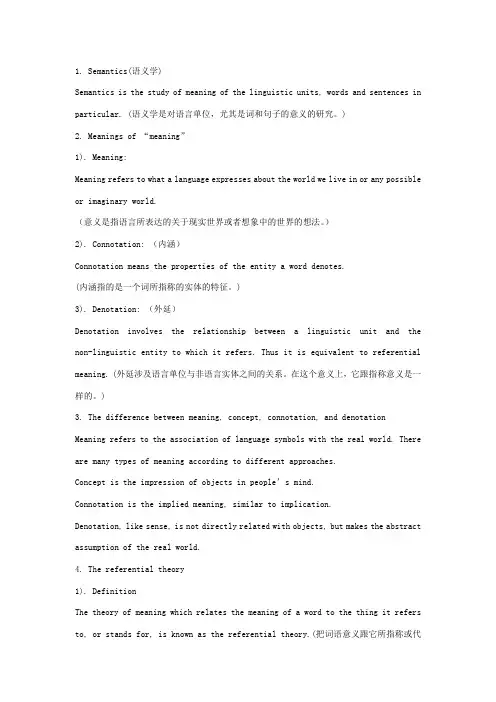
1. Semantics(语义学)Semantics is the study of meaning of the linguistic units, words and sentences in particular. (语义学是对语言单位,尤其是词和句子的意义的研究。
)2. Meanings of “meaning”1). Meaning:Meaning refers to what a language expresses about the world we live in or any possible or imaginary world.(意义是指语言所表达的关于现实世界或者想象中的世界的想法。
)2). Connotation: (内涵)Connotation means the properties of the entity a word denotes.(内涵指的是一个词所指称的实体的特征。
)3). Denotation: (外延)Denotation involves the relationship between a linguistic unit and the non-linguistic entity to which it refers. Thus it is equivalent to referential meaning. (外延涉及语言单位与非语言实体之间的关系。
在这个意义上,它跟指称意义是一样的。
)3. The difference between meaning, concept, connotation, and denotationMeaning refers to the association of language symbols with the real world. There are many types of meaning according to different approaches.Concept is the impression of objects in people’s mind.Connotation is the implied meaning, similar to implication.Denotation, like sense, is not directly related with objects, but makes the abstract assumption of the real world.4. The referential theory1). DefinitionThe theory of meaning which relates the meaning of a word to the thing it refers to, or stands for, is known as the referential theory.(把词语意义跟它所指称或代表的事物联系起来的理论,叫做指称理论)2). The semantic triangle (语义三角)Ogden and Richards presented the classic “Semantic Triangle” as manifested in the following diagram。
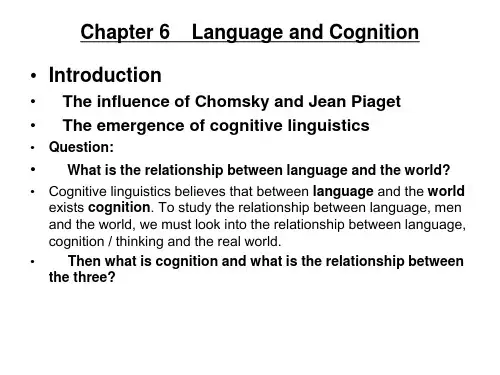
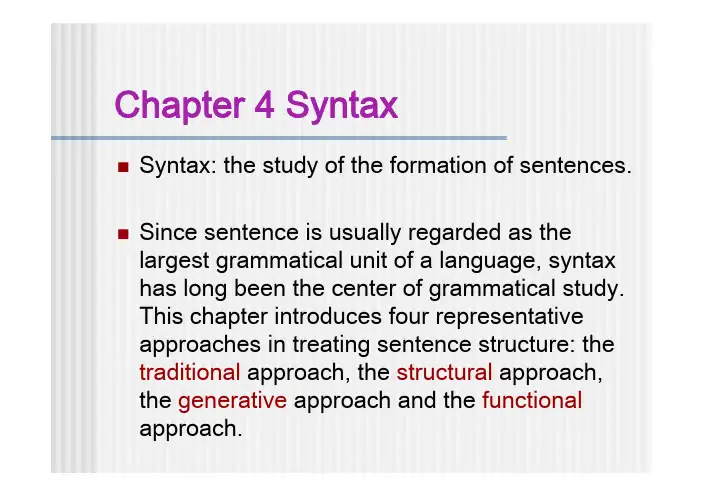
Chapter 4 SyntaxSyntax: the study of the formation of sentences. Since sentence is usually regarded as the largest grammatical unit of a language, syntax has long been the center of grammatical study. This chapter introduces four representative approaches in treating sentence structure: the traditional approach, the structural approach, the generative approach and the functional approach.4.1 The traditional approach4.1.1 Number, gender and caseNumber: singular and pluralCase:1)Pronouns: nominative(I, he, she), accusative(me, him,her), genetive(my, your, his)2)Nouns: general(John, boy), genitive(John’s, boys’)4.1.2 Tense and aspectTenses: past and presentAspect: perfective(perfect) and progressive(continuous)4.1.3 Concord and governmentConcord(Agreement) is the requirement that the forms of two or more words in a syntactic relationship should agree with each other in terms of some categories. Eg. this man, these men; a book, some booksGovernment is another type of control the form of some words by other words in certain syntactic constructions. It differs from concord in that this is a relationship in which a word of a certain class determines the form of others in terms of certain category.Eg. She gave him a book. She gave a book to him.4.2 The structural approach4.2.1 Syntagmatic and paradigmatic relations (Saussure) -Signified(concept) and signifier (sound image)-Syntagmatic relation(structure, horizontal relation,chain relation):the relation between one item and others in a sequence-Paradigmatic relation(system, vertical relation, choicerelation): the relation between elements replaceable with each other at a particular place in a structure, or between one element present and the others absent.4.2.2 Immediate constituent analysis(IC analysis)-construction and constituents(Bloomfield)-immediate constituents-ultimate constituents-IC analysis:the analysis of a sentence in terms of its immediate constituents---word groups (or phrases), which are in turn analyzed into the immediate constituents of their own, and the process goes on until the ultimate constituents are reached.ex.1 (a) ( ( Poor) (John) ) ( ( ran) ( away) )(b) Poor John ran awayex.2 John left yesterdayex.3 dis place mentAdvantage:Through IC analysis, the internal structure of a sentence may be demonstrated clearly, and ambiguities will be revealed.Ex. 1.(a) Leave the book on the shelf(b) Leave the book on the shelf(b) my small child’s cot(c) my small child’s cotEx.3(a) The son of Pharaoh’s daughter is the daughter of Pharaoh’s son(b) The son of Pharaoh’s daughter is the daughter of Pharaoh’s sonEx.4(Labelled tree diagram)more expensive clothes more expensive clothes Adj Adj N Adv Adj NNP APNP NPEx.5(Is he really) that kind? (Is he really) that kind?Det N Adv AdjNP APEX.6They can fish herePron Aux V AdvPron V N Adv-Problems:1) Binary division ? Old men and women2) Discontinuous constituents ? make it up4.2.3 Endocentric and exocentric constructions-Endocentric construction(headed construction) is a construction whose distribution isfunctionally equivalent, or approachingequivalence, to one of its constituents, whichserve as the center/head of the whole.e.g. poor John, the three small children1) Subordinate construction:only one head (e.g.really very late, the book on the shelf, walked away immediately)2) Coordinate construction:more than one head(e.g.boys and girls, coffee or tea, the city Rome)-Exocentric construction is a construction whose distribution is not functionally equivalent to any of its constituents.e.g.Prepositional phrases :on the shelf, if he is goingBasic sentences :The girl smiled.? Verb plus object constructions :visit Bill, read books。
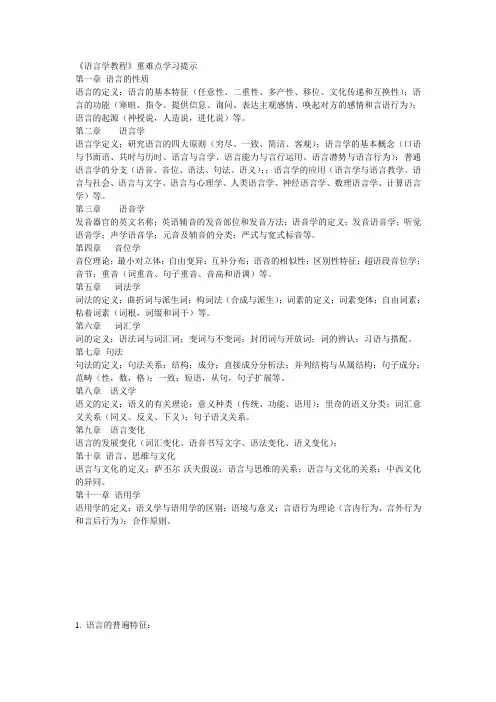
《语言学教程》重难点学习提示第一章语言的性质语言的定义:语言的基本特征(任意性、二重性、多产性、移位、文化传递和互换性);语言的功能(寒暄、指令、提供信息、询问、表达主观感情、唤起对方的感情和言语行为);语言的起源(神授说,人造说,进化说)等。
第二章语言学语言学定义;研究语言的四大原则(穷尽、一致、简洁、客观);语言学的基本概念(口语与书面语、共时与历时、语言与言学、语言能力与言行运用、语言潜势与语言行为);普通语言学的分支(语音、音位、语法、句法、语义);;语言学的应用(语言学与语言教学、语言与社会、语言与文字、语言与心理学、人类语言学、神经语言学、数理语言学、计算语言学)等。
第三章语音学发音器官的英文名称;英语辅音的发音部位和发音方法;语音学的定义;发音语音学;听觉语音学;声学语音学;元音及辅音的分类;严式与宽式标音等。
第四章音位学音位理论;最小对立体;自由变异;互补分布;语音的相似性;区别性特征;超语段音位学;音节;重音(词重音、句子重音、音高和语调)等。
第五章词法学词法的定义;曲折词与派生词;构词法(合成与派生);词素的定义;词素变体;自由词素;粘着词素(词根,词缀和词干)等。
第六章词汇学词的定义;语法词与词汇词;变词与不变词;封闭词与开放词;词的辨认;习语与搭配。
第七章句法句法的定义;句法关系;结构;成分;直接成分分析法;并列结构与从属结构;句子成分;范畴(性,数,格);一致;短语,从句,句子扩展等。
第八章语义学语义的定义;语义的有关理论;意义种类(传统、功能、语用);里奇的语义分类;词汇意义关系(同义、反义、下义);句子语义关系。
第九章语言变化语言的发展变化(词汇变化、语音书写文字、语法变化、语义变化);第十章语言、思维与文化语言与文化的定义;萨丕尔-沃夫假说;语言与思维的关系;语言与文化的关系;中西文化的异同。
第十一章语用学语用学的定义;语义学与语用学的区别;语境与意义;言语行为理论(言内行为、言外行为和言后行为);合作原则。
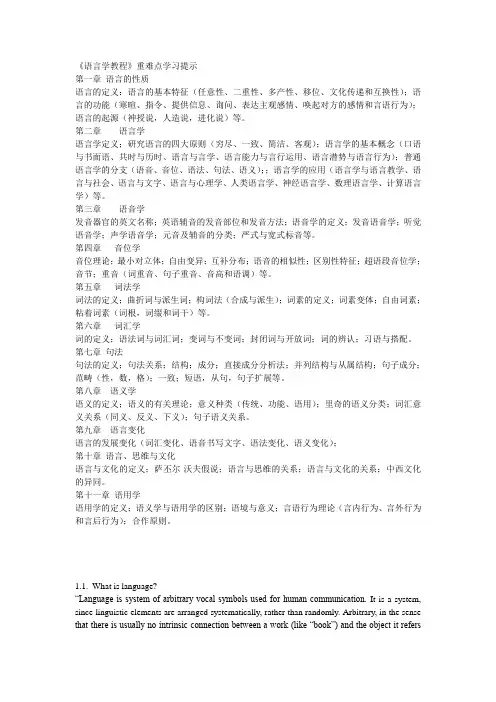
《语言学教程》重难点学习提示第一章语言的性质语言的定义:语言的基本特征(任意性、二重性、多产性、移位、文化传递和互换性);语言的功能(寒暄、指令、提供信息、询问、表达主观感情、唤起对方的感情和言语行为);语言的起源(神授说,人造说,进化说)等。
第二章语言学语言学定义;研究语言的四大原则(穷尽、一致、简洁、客观);语言学的基本概念(口语与书面语、共时与历时、语言与言学、语言能力与言行运用、语言潜势与语言行为);普通语言学的分支(语音、音位、语法、句法、语义);;语言学的应用(语言学与语言教学、语言与社会、语言与文字、语言与心理学、人类语言学、神经语言学、数理语言学、计算语言学)等。
第三章语音学发音器官的英文名称;英语辅音的发音部位和发音方法;语音学的定义;发音语音学;听觉语音学;声学语音学;元音及辅音的分类;严式与宽式标音等。
第四章音位学音位理论;最小对立体;自由变异;互补分布;语音的相似性;区别性特征;超语段音位学;音节;重音(词重音、句子重音、音高和语调)等。
第五章词法学词法的定义;曲折词与派生词;构词法(合成与派生);词素的定义;词素变体;自由词素;粘着词素(词根,词缀和词干)等。
第六章词汇学词的定义;语法词与词汇词;变词与不变词;封闭词与开放词;词的辨认;习语与搭配。
第七章句法句法的定义;句法关系;结构;成分;直接成分分析法;并列结构与从属结构;句子成分;范畴(性,数,格);一致;短语,从句,句子扩展等。
第八章语义学语义的定义;语义的有关理论;意义种类(传统、功能、语用);里奇的语义分类;词汇意义关系(同义、反义、下义);句子语义关系。
第九章语言变化语言的发展变化(词汇变化、语音书写文字、语法变化、语义变化);第十章语言、思维与文化语言与文化的定义;萨丕尔-沃夫假说;语言与思维的关系;语言与文化的关系;中西文化的异同。
第十一章语用学语用学的定义;语义学与语用学的区别;语境与意义;言语行为理论(言内行为、言外行为和言后行为);合作原则。
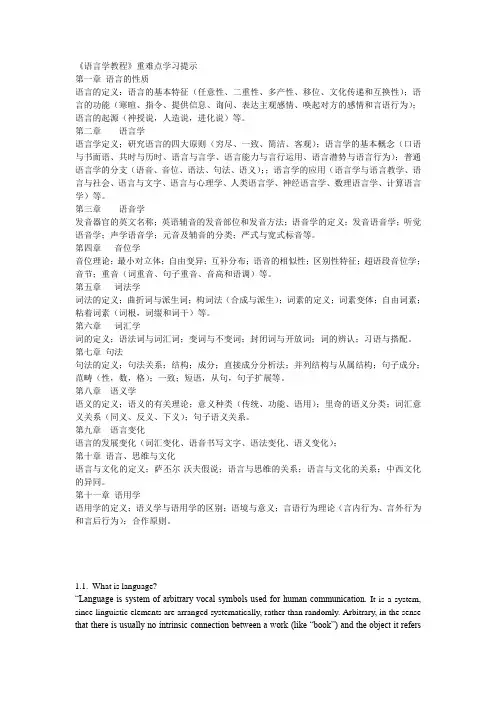
《语言学教程》重难点学习提示第一章语言的性质语言的定义:语言的基本特征(任意性、二重性、多产性、移位、文化传递和互换性);语言的功能(寒暄、指令、提供信息、询问、表达主观感情、唤起对方的感情和言语行为);语言的起源(神授说,人造说,进化说)等。
第二章语言学语言学定义;研究语言的四大原则(穷尽、一致、简洁、客观);语言学的基本概念(口语与书面语、共时与历时、语言与言学、语言能力与言行运用、语言潜势与语言行为);普通语言学的分支(语音、音位、语法、句法、语义);;语言学的应用(语言学与语言教学、语言与社会、语言与文字、语言与心理学、人类语言学、神经语言学、数理语言学、计算语言学)等。
第三章语音学发音器官的英文名称;英语辅音的发音部位和发音方法;语音学的定义;发音语音学;听觉语音学;声学语音学;元音及辅音的分类;严式与宽式标音等。
第四章音位学音位理论;最小对立体;自由变异;互补分布;语音的相似性;区别性特征;超语段音位学;音节;重音(词重音、句子重音、音高和语调)等。
第五章词法学词法的定义;曲折词与派生词;构词法(合成与派生);词素的定义;词素变体;自由词素;粘着词素(词根,词缀和词干)等。
第六章词汇学词的定义;语法词与词汇词;变词与不变词;封闭词与开放词;词的辨认;习语与搭配。
第七章句法句法的定义;句法关系;结构;成分;直接成分分析法;并列结构与从属结构;句子成分;范畴(性,数,格);一致;短语,从句,句子扩展等。
第八章语义学语义的定义;语义的有关理论;意义种类(传统、功能、语用);里奇的语义分类;词汇意义关系(同义、反义、下义);句子语义关系。
第九章语言变化语言的发展变化(词汇变化、语音书写文字、语法变化、语义变化);第十章语言、思维与文化语言与文化的定义;萨丕尔-沃夫假说;语言与思维的关系;语言与文化的关系;中西文化的异同。
第十一章语用学语用学的定义;语义学与语用学的区别;语境与意义;言语行为理论(言内行为、言外行为和言后行为);合作原则。
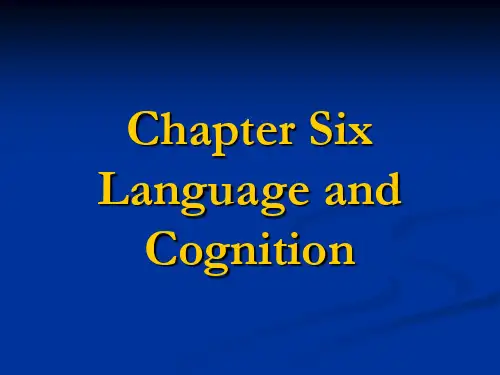
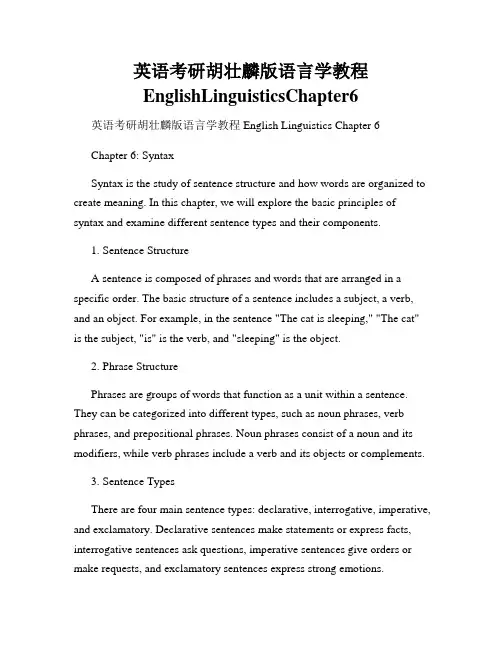
英语考研胡壮麟版语言学教程EnglishLinguisticsChapter6英语考研胡壮麟版语言学教程English Linguistics Chapter 6Chapter 6: SyntaxSyntax is the study of sentence structure and how words are organized to create meaning. In this chapter, we will explore the basic principles of syntax and examine different sentence types and their components.1. Sentence StructureA sentence is composed of phrases and words that are arranged in a specific order. The basic structure of a sentence includes a subject, a verb, and an object. For example, in the sentence "The cat is sleeping," "The cat" is the subject, "is" is the verb, and "sleeping" is the object.2. Phrase StructurePhrases are groups of words that function as a unit within a sentence. They can be categorized into different types, such as noun phrases, verb phrases, and prepositional phrases. Noun phrases consist of a noun and its modifiers, while verb phrases include a verb and its objects or complements.3. Sentence TypesThere are four main sentence types: declarative, interrogative, imperative, and exclamatory. Declarative sentences make statements or express facts, interrogative sentences ask questions, imperative sentences give orders or make requests, and exclamatory sentences express strong emotions.4. Sentence ComponentsIn addition to the basic subject-verb-object structure, sentences can also include other components such as adjectives, adverbs, and conjunctions. Adjectives modify nouns, adverbs modify verbs, and conjunctions connect words or phrases.5. Sentence TransformationsSyntax also involves the study of how sentences can be transformed or modified. Some common transformations include changing the word order, forming questions or negations, and using different sentence structures to convey the same meaning.6. Syntactic AnalysisSyntactic analysis is the process of examining the structure of a sentence to determine its grammatical correctness. It involves identifying the different parts of speech, analyzing phrase structures, and checking for agreement between words.7. Sentence ParsingSentence parsing is the process of breaking down a sentence into its constituent parts and determining the relationships between them. It helps in understanding the overall meaning of a sentence and how its components interact with each other.ConclusionSyntax plays a crucial role in understanding how sentences are structured and how meaning is created through word order and sentencetransformations. By studying the principles of syntax, we can gain a deeper understanding of the English language and enhance our language skills.Note: This article is written in a general format that is suitable for discussing the topic of syntax. The specific format of the "English Linguistics Chapter 6" would depend on the guidelines provided in the course materials.。
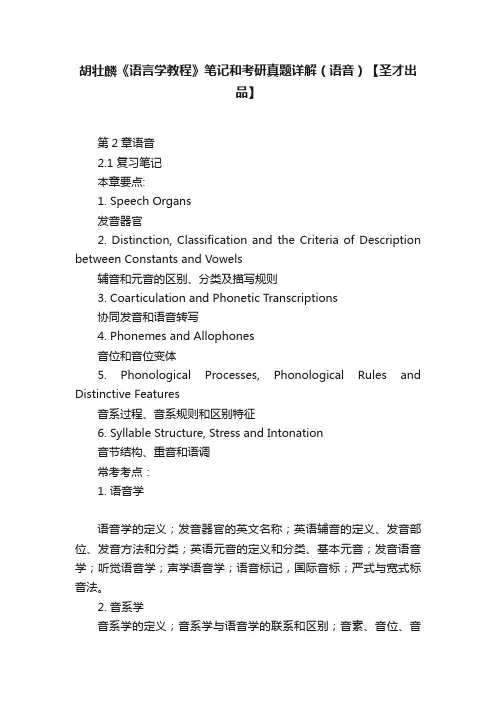
胡壮麟《语言学教程》笔记和考研真题详解(语音)【圣才出品】第2章语音2.1 复习笔记本章要点:1. Speech Organs发音器官2. Distinction, Classification and the Criteria of Description between Constants and Vowels辅音和元音的区别、分类及描写规则3. Coarticulation and Phonetic Transcriptions协同发音和语音转写4. Phonemes and Allophones音位和音位变体5. Phonological Processes, Phonological Rules and Distinctive Features音系过程、音系规则和区别特征6. Syllable Structure, Stress and Intonation音节结构、重音和语调常考考点:1. 语音学语音学的定义;发音器官的英文名称;英语辅音的定义、发音部位、发音方法和分类;英语元音的定义和分类、基本元音;发音语音学;听觉语音学;声学语音学;语音标记,国际音标;严式与宽式标音法。
2. 音系学音系学的定义;音系学与语音学的联系和区别;音素、音位、音位变体、最小对立体、自由变体的定义;音位理论;自由变异;音位的对立分布与互补分布;语音的相似性;区别性特征;超语段音位学;音节;重音(词重音、句子重音);音高和语调。
本章内容索引:I. The Definition of Phonetics and Phonology1. Phonetics2. Three Major Research Fields of Phonetics3. PhonologyII. Speech Organs1. Speech organs2. Voiceless sounds3. Voiced sounds4. IPAIII. Consonants and Vowels1. Definition2. Consonants(1) Manner of Articulation and Place of Articulation(2) Classification of Consonants3. Vowel(1) Cardinal vowels(2) Criteria of vowel description(3) Monophthongs, Diphthongs and TriphthongsIV. Coarticulation and Phonetic Transcriptions1. Coarticulation2. Phonetic TranscriptionV. Phonemes and Allophones1. Phoneme2. AllophonesVI. Phonological Processes and Distinctive Features1. Phonological processes2. Assimilation3. Distinctive featuresVII. Suprasegmentals1. Suprasegmental features2. The Syllable Structure3. Stress4. Intonation and ToneI. The Definition of Phonetics and Phonology (语音学和音系学的定义)1. Phonetics (语音学)Phonetics studies how speech sounds are produced, transmitted, and perceived.语音学研究语音的发生、传递和感知。

《语言学教程》重难点学习提示第一章语言的性质语言的定义:语言的基本特征(任意性、二重性、多产性、移位、文化传递和互换性);语言的功能(寒暄、指令、提供信息、询问、表达主观感情、唤起对方的感情和言语行为);语言的起源(神授说,人造说,进化说)等。
第二章语言学语言学定义;研究语言的四大原则(穷尽、一致、简洁、客观);语言学的基本概念(口语与书面语、共时与历时、语言与言学、语言能力与言行运用、语言潜势与语言行为);普通语言学的分支(语音、音位、语法、句法、语义);;语言学的应用(语言学与语言教学、语言与社会、语言与文字、语言与心理学、人类语言学、神经语言学、数理语言学、计算语言学)等。
第三章语音学发音器官的英文名称;英语辅音的发音部位和发音方法;语音学的定义;发音语音学;听觉语音学;声学语音学;元音及辅音的分类;严式与宽式标音等。
第四章音位学音位理论;最小对立体;自由变异;互补分布;语音的相似性;区别性特征;超语段音位学;音节;重音(词重音、句子重音、音高和语调)等。
第五章词法学词法的定义;曲折词与派生词;构词法(合成与派生);词素的定义;词素变体;自由词素;粘着词素(词根,词缀和词干)等。
第六章词汇学词的定义;语法词与词汇词;变词与不变词;封闭词与开放词;词的辨认;习语与搭配。
第七章句法句法的定义;句法关系;结构;成分;直接成分分析法;并列结构与从属结构;句子成分;范畴(性,数,格);一致;短语,从句,句子扩展等。
第八章语义学语义的定义;语义的有关理论;意义种类(传统、功能、语用);里奇的语义分类;词汇意义关系(同义、反义、下义);句子语义关系。
第九章语言变化语言的发展变化(词汇变化、语音书写文字、语法变化、语义变化);第十章语言、思维与文化语言与文化的定义;萨丕尔-沃夫假说;语言与思维的关系;语言与文化的关系;中西文化的异同。
第十一章语用学语用学的定义;语义学与语用学的区别;语境与意义;言语行为理论(言内行为、言外行为和言后行为);合作原则。
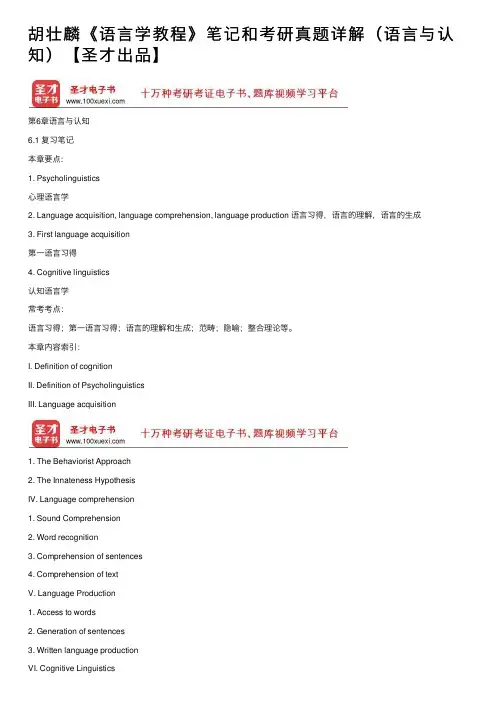
胡壮麟《语⾔学教程》笔记和考研真题详解(语⾔与认知)【圣才出品】第6章语⾔与认知6.1 复习笔记本章要点:1. Psycholinguistics⼼理语⾔学2. Language acquisition, language comprehension, language production 语⾔习得,语⾔的理解,语⾔的⽣成3. First language acquisition第⼀语⾔习得4. Cognitive linguistics认知语⾔学常考考点:语⾔习得;第⼀语⾔习得;语⾔的理解和⽣成;范畴;隐喻;整合理论等。
本章内容索引:I. Definition of cognitionII. Definition of PsycholinguisticsIII. Language acquisition1. The Behaviorist Approach2. The Innateness HypothesisIV. Language comprehension1. Sound Comprehension2. Word recognition3. Comprehension of sentences4. Comprehension of textV. Language Production1. Access to words2. Generation of sentences3. Written language productionVI. Cognitive Linguistics1. Definition2. Construal and Construal Operations(1) Attention/ Salience(2) Judgment/ Comparison(3) Perspective/ Situatedness3. Categorization(1) Basic level(2) Superordinate level(3) Subordinate level4. Image Schemas5. Metaphor(1) Ontological metaphors(2) Structural metaphors(3) Orientional metaphors6. Metonymy7. Blending TheoryI. Definition of cognition (认知的定义)Cognition is used in several different loosely related disciplines. In psychology it is used to refer to the mental processes of an individual, with particular relation to a concept which argues that the mind has internal mental states (such as beliefs, desires and intentions) and can be understood as information processing, especially when much abstraction or concretization is involved, or processes such as involving knowledge, expertise or learning for example are at work. Another definition of “cognition” is the mental process or faculty of knowing, including aspects such as awareness, perception, reasoning, and judgment.“认知”⼀词既可⽤于不同学科也可⽤于相关学科。
胡壮麟语言学教程第6章专业术语解释1. Psycholinguistics is the study of psychological aspects of language; it usually studies the psychological states and mental activity associated withthe use of language. As an interdisciplinary academic field basied on psychology and linguistics, psycholinguistics investigates the six following subjects: language acquisition, language comprehension, language production, language disorders,language and thought, and cognitive architecture of language, the most important research subjects are acquisition, comprehension and production.2. Language acquisition is one of the central topics in psycholinguistics. Acquiring a first language is something every child does successfully, in a matter of a few years and without the need for formal lessons. Four phrasesare identified and acknowledged in the process of language acquisition: holophrastic stage, two-word stage, three-word utterances, and, fluent grammatical conversation stage.3. holophrastic stage is the first phase of language acquisition. The main linguistic accomplishments during this stage are control of the speech musculature and sensitivity to the phonetic distinctions used in the parents’ language. Shortly before their first birthday, babies begin to unstand words, and around that birthday, they start to produce them.4. two-word stage is the second phase of language acquisition. Around 18 months, the child begins to learn words at the rate of one everytwo walking hours, and keeps learning that rate or faster through adolescence.5. Three-word utterances stage is the third phase of language acquisition. Three-word utterances look like samples drawn from longer potential sentences expressing a complete and more complated idea.6. connectionism: With respection to the respect to language comprehension, connectionism in psycholinguistics claims that readers use the same system of links between spelling units and sound units to generate the pronunciations of written words and to access the pronunciations of familiar words, or wordsthat are exceptions to these patterns. In this view, similarity and frequency play important roles in processing and comprehending language, with the novel iterms being processed based on their similarity to known ones. 7. Cohortmodel is a supposed doctrine dealing with the spoken word recognitionpostulation postulated by Marslen-Wilson and Welsh in 1990. It is suggestedthat the first few phonemes of a spoken word activate a set or cohort of word candidates that are consistent with the input. These candidates compete with one another for activation. As more acoustic input is analyzed, candidatesthat are no longer consistent with the input drop out of the set. This process continues until only one word candidate is a clear winner.8. Interactive model holds that in recognizing the spoken words higherprocessing levels have direct, “top-down” influence on lower levels. Lexical knowedge can affect the perception of phonemes. There is interactivity in the formal of lexical effects on the perception of sublexical units. In certain cases, listeners’ knowledge of words can lead to the inhibition of certain phonems; in other cases, listeners continue to “hear” phonemes that have been removed from the speech signal and replaced by noise.9. Race model suggests in spoken word recognition there are two routes that race each other―a pre-lexical route, which computers phonological information from the acoustic signal, and a lexical route in which the phonological information associated with a word becomes available when theword itself is accessed When word―level information appears to affect alower-level process, it is assumed that the lexical route won the race.10. Serial model proposes that the sentence comprehension systemcontinually and sequentially follows the constraints of a language grammarwith remarkable speed. serial model describes how the processor quickly constructs one or more representations of a sentence based on a restricted range of information that is guaranteed to be relevant to itsinterpretation ,primarily grammatical information .Any such representation is then quickly interpreted and evaluated, using the full range of information that might be relevant.11. Parallel model emphasizes that the comprehension system is sensitiveto a vast range of information .including grammatical, lexical, and contextual, as well as knowledge of the speaker\\writer and of the world in general.parallel model describes how the processor users all relevant information to quickly evaluate the full range of possible interpretations of a sentence .itis generally acknowledged that listener and readers integrate and situational knowledge in understanding a sentence.12. Resonance model is a model about text comprehension, in this model , information in long-term memory is automatically activated by the presence of material that apparently bears a rough semantic relation to it .semantic details, including factors such as negation that drastically change the truthof propositions , do not seem to affect the resonance process. It emphasized a more active and intelligent search for meaning as the basis by which a reader discovers the conceptual structure of a discourse. In reading a narrative text, reader attempts to build a representation of the causal structure of the text. analyzing events in terms of goals ,actions, and reactions . A resonance process serves as first stage in processing a text, and , reading objectives and details of text structure determine whatever a reader goes further searches for a coherent structure for the text.13. Construal is the ability to conceive and portray the same situation inalternate ways through specificity, different mental scanning, directionality, vantage point, figure-ground segregation etc.14. Construal operations are conceptualizing processes used in language process by human beings. That is, construal operations are the underlying psychological processes and resources employed in the interpretation of linguistic expressions.15. Figure-ground alignment seems to apply to space with the ground as the prepositional object and the preposition expressing the spatial relation configuration. It also applies to human perception of moving object. Since the moving object is typically the most prominent one, because it is moving, it is typically the figure, while the remaining stimuli constitute the ground.16. Trajector means a moving or dynamic figure.17. Landmark means the ground provided for a moving figure.18. Basic level category is the most economical level at which you canfind the most relevant information. The information on our interactions with objects in the real world are stored at this level. It is at this level thatwe conjure up the gestalt of the category.19. Subordinate level is the level at which we perceive the differences between the members of the basic level categories.20. Image schema is a recurring, dynamic pattern of our perceptual interactions and motor programs that gives coherence and structure toour experience.21. Metaphor involves the comparison of two concepts in that one is construed in terms of the others. It’s often described in terms of a target domain and a source domain. The target domain is the experience being described by the metaphor and the source domain is the means that we use in order to describe the experience.22. Metonymy is a figure of speech that has to do with the substitution of the name of one thing for that of another.23. Ontological metaphors mean that human experiences with physical objects provide the basis for ways of viewing events, activities, emotions, ideas, etc., as entities and substances.24. Structural metaphors play the most important role because they allow us to go beyond orientation and referring and give us the possibility to structure one concept according to another.25. Generic space maps onto each of the inputs. It reflects some common, usually more abstuct, structure and organization shared by the inputs. It defines the core cross-space mapping between them.26. Blend space is the fourth space onto which is partially projected by inputs I1 and I2.感谢您的阅读,祝您生活愉快。
Chapter one Introduction一、定义1.语言学LinguisticsLinguistics is generally defined as the scientific study of language.2.普通语言学General LinguisticsThe study of language as a whole is often called General linguistics.3.语言languageLanguage is a system of arbitrary vocal symbols used for human communication.语言是人类用来交际的任意性的有声符号体系。
4.识别特征Design FeaturesIt refers to the defining poperties of human language that distinguish it from any animal system of communication.语言识别特征是指人类语言区别与其他任何动物的交际体系的限定性特征。
Arbitrariness任意性Productivity多产性Duality双重性Displacement移位性Cultural transmission文化传递⑴arbitrarinessThere is no logical connection between meanings and sounds.P.S the arbitrary nature of language is a sign of sophistication and it makes it possible for language to have an unlimited source of expressions⑵ProductivityAnimals are quite limited in the messages they are able to send.⑶DualityLanguage is a system, which consists of two sets of structures ,or two levels.⑷DisplacementLanguage can be used to refer to contexts removed from the immediate situations of the speaker.⑸Cultural transmissionHuman capacity for language has a genetic basis, but we have to be taught and learned the details of any language system. this showed that language is culturally transmitted. not by instinct. animals are born with the capacity to produce the set of calls peculiar to their species.5.语言能力CompetenceCompetence is the ideal user’s knowledge of the rules of his language.6.语言运用performancePerformance is the actual realization of this knowledge in linguistic communication.语言运用是所掌握的规那么在语言交际中的表达。
每本教材每个章节都包含:学霸笔记,强化练习,过关检测,思维导图,复习要点,学习目标,时间安排,重难点分析,易错点分析,考点分析,音频笔记等......如果参考教材有多个版本,那么每个版本都有全套资料;如果目标院校没有指定参考书,那么所有推荐的参考书都有全套的资料可供学习。
以下是胡壮麟《语言学教程》第6章《语言与认知》的复习攻略:1.复习要点本章主要内容包括以下方面:(1)语言的认知过程:感知、注意、记忆等。
(2)语言的信息加工:语音、语义、语用等。
(3)语言与思维:内在语言(自我对话)、概念与类别等。
2.学习目标通过本章的学习,你应该能够:(1)理解语言的认知过程,掌握感知、注意、记忆等认知过程的基本原理。
(2)掌握语言信息加工的原理和方法,了解语音、语义、语用的基本概念和分析方法。
(3)了解语言与思维的关系,掌握内在语言(自我对话)的特点和作用,以及概念与类别的基本概念和分类方法。
3.时间安排上午:阅读第6章,理解语言的认知过程和信息加工的原理和方法。
下午:学习语音、语义、语用的基本概念和分析方法,以及内在语言(自我对话)的特点和作用。
晚上:了解概念与类别的基本概念和分类方法,进行练习和实验操作,加深对概念和方法的理解和记忆。
4.总结通过以上复习要点和学习目标,你可以在1天内全面了解胡壮麟《语言学教程》第6章《语言与认知》的内容,并掌握语言的认知过程和信息加工的原理和方法。
同时,还应该了解语言与思维的关系,掌握内在语言(自我对话)的特点和作用,以及概念与类别的基本概念和分类方法。
建议在学习过程中注重实践和思考,多进行练习和实验操作,加深对概念和方法的理解和记忆。
同时,还应该注意扩大知识面,关注语言学的前沿研究和应用领域,为未来的学术研究和职业发展打下坚实的基础。
《语言学教程》重难点学习提示第一章语言的性质语言的定义:语言的基本特征(任意性、二重性、多产性、移位、文化传递和互换性);语言的功能(寒暄、指令、提供信息、询问、表达主观感情、唤起对方的感情和言语行为);语言的起源(神授说,人造说,进化说)等。
第二章语言学语言学定义;研究语言的四大原则(穷尽、一致、简洁、客观);语言学的基本概念(口语与书面语、共时与历时、语言与言学、语言能力与言行运用、语言潜势与语言行为);普通语言学的分支(语音、音位、语法、句法、语义);;语言学的应用(语言学与语言教学、语言与社会、语言与文字、语言与心理学、人类语言学、神经语言学、数理语言学、计算语言学)等。
第三章语音学发音器官的英文名称;英语辅音的发音部位和发音方法;语音学的定义;发音语音学;听觉语音学;声学语音学;元音及辅音的分类;严式与宽式标音等。
第四章音位学音位理论;最小对立体;自由变异;互补分布;语音的相似性;区别性特征;超语段音位学;音节;重音(词重音、句子重音、音高和语调)等。
第五章词法学词法的定义;曲折词与派生词;构词法(合成与派生);词素的定义;词素变体;自由词素;粘着词素(词根,词缀和词干)等。
第六章词汇学词的定义;语法词与词汇词;变词与不变词;封闭词与开放词;词的辨认;习语与搭配。
第七章句法句法的定义;句法关系;结构;成分;直接成分分析法;并列结构与从属结构;句子成分;范畴(性,数,格);一致;短语,从句,句子扩展等。
第八章语义学语义的定义;语义的有关理论;意义种类(传统、功能、语用);里奇的语义分类;词汇意义关系(同义、反义、下义);句子语义关系。
第九章语言变化语言的发展变化(词汇变化、语音书写文字、语法变化、语义变化);第十章语言、思维与文化语言与文化的定义;萨丕尔-沃夫假说;语言与思维的关系;语言与文化的关系;中西文化的异同。
第十一章语用学语用学的定义;语义学与语用学的区别;语境与意义;言语行为理论(言内行为、言外行为和言后行为);合作原则。
Chapter 1 Invitations to linguistics1.2 what is languageLanguage is a system of arbitrary vocal symbols for human communication1.3 design features of languagearbitrariness: there is no connection between the words; sound and its meaningduality: the property of having two levels of structurescreativity(productivity): users can produce sentences they have never heard before. Its potential to create endless sentences by recursiveness.displacement: language can be used to refer to the context removed from the immediate situation of the speakers.cultural transmission: language is passed o through teaching and learning , rather than by instinct.1.4 origin of languageThe bow-wow theory: imitate the sounds of animalThe pooh-pooh theory: instinctive sounds of joy, ager and painThe yo-he-ho theory: rhythmic grunts produced when working1.5 functions of language1.5.1 the main functions of language:Descriptive functions: cognitive or referential or propositional function. Primary function of language. , to convey factual informationExpressive function: emotive or attitudinal function, supplies users’ feelings, preferences, prejudices, and values.Social function: interpersonal function, serves to establish and maintain social relations between people1.5.2 according to Jakobson:Emotive: addresser 表达情感Conative: addressee 导致动作的发生Referential: context描述客观事实Poetic: message语言本身的美Phatic communication: contact建立社会关系Metalinguistic: code make clear the meaning of language itself1.5.3 according to Halliday this system contains three macrofunctionsIdeational: to organize the speaker or writer’s experience of the real or imaginary world. 达意功能指组织说话者或作者现实或虚伪世界的体验,即语言指称实际或虚伪的人,物,动作,事件,状态等Interpersonal: to indicate, establish or maintain social relationships between people.人际功能表明,建立,或维持人与人之间的社会关系,包括称谓形式,情感,语言功能等。
Chapter 2 Speech Sounds2.1 Speech production and perceptionPhonetics is the study of speech sounds. It includes three main areas:1. Articulatory phonetics – the study of the production of speech sounds2. Acoustic phonetics –the study of the physical properties of the sounds produced inspeech3. Auditory phonetics – the study of perception of speech soundsMost phoneticians are interested in articulatory phonetics.2.2 Speech organsSpeech organs are those parts of the human body involved in the production of speech. The speech organs can be considered as consisting of three parts: the initiator of the air stream, the producer of voice and the resonating cavities.2.3 Segments, divergences, and phonetic transcription2.3.1 Segments and divergencesAs there are more sounds in English than its letters, each letter must represent more than one sound.2.3.2 Phonetic transcriptionInternational Phonetic Alphabet (IPA): the system of symbols for representing the pronunciation of words in any language according to the principles of the InternationalPhonetic Association. The symbols consists of letters and diacritics. Some letters aretaken from the Roman alphabet, some are special symbols.2.4 Consonants2.4.1 Consonants and vowelsA consonant is produced by constricting or obstructing the vocal tract at someplaces to divert, impede, or completely shut off the flow of air in the oral cavity.A vowel is produced without obstruction so no turbulence or a total stopping of theair can be perceived.2.4.2 ConsonantsThe categories of consonant are established on the basis of several factors. The most important of these factors are:1. the actual relationship between the articulators and thus the way in which theair passes through certain parts of the vocal tract (manner of articulation);2. where in the vocal tract there is approximation, narrowing, or the obstructionof the air (place of articulation).2.4.3 Manners of articulation1. Stop/plosive: A speech sound which is produced by stopping the air streamfrom the lungs and then suddenly releasing it. In English,[☐ ♌ ♦ ♎ ♑] are stops and [❍ ⏹ ☠]are nasal stops.2. Fricative: A speech sound which is produced by allowing the air stream fromthe lungs to escape with friction. This is caused by bringing the twoarticulators, e.g. the upper teeth and the lower lip, close together but notcloses enough to stop the airstreams completely. In English,[♐ ❆ ♦ ☞ ✞ ♒] are fricatives.3. (Median) approximant: An articulation in which one articulator is close toanother, but without the vocal tract being narrowed to such an extent that aturbulent airstream is produced. In English this class of sounds includes[♦ ❒ ].4. Lateral (approximant): A speech sound which is produced by partiallyblocking the airstream from the lungs, usually by the tongue, but letting itescape at one or both sides of the blockage. [●] is the only lateral in English.Other consonantal articulations include trill, tap or flap, and affricate.2.4.4 Places of articulation1. Bilabial: A speech sound which is made with the two lips.2. Labiodental: A speech sound which is made with the lower lip and the upperfront teeth.3. Dental: A speech sound which is made by the tongue tip or blade and theupper front teeth.4. Alveolar: A speech sound which is made with the tongue tip or blade and thealveolar ridge.5. Postalveolar: A speech sound which is made with the tongue tip and the backof the alveolar ridge.6. Retroflex: A speech sound which is made with the tongue tip or blade curledback so that the underside of the tongue tip or blade forms a stricture with theback of the alveolar ridge or the hard palate.7. Palatal: A speech sound which is made with the front of the tongue and thehard palate.8. Velar: A speech sound which is made with the back of the tongue and the softpalate.9. Uvular: A speech sound which is made with the back of the tongue and theuvula, the short projection of the soft tissue and muscle at the posterior end ofthe velum.10. Pharyngeal: A speech sound which is made with the root of the tongue and thewalls of the pharynx.11. Glottal: A speech sound which is made with the two pieces of vocal foldspushed towards each other.2.4.5 The consonants of EnglishReceived Pronunciation (RP): The type of British Standard English pronunciation which has been regarded as the prestige variety and which shows no regional variation.It has often been popularly referred to as “BBC English” or “Oxford English” because it is widely used in the private sector of the education system and spoken by mostnewsreaders of the BBC network.articulation. These pairs of consonants are distinguished by voicing, the one appearingon the left is voiceless and the one on the right is voiced.Therefore, the consonants of English can be described in the following way:[p] voiceless bilabial stop[b] voiced bilabial stop[s] voiceless alveolar fricative[z] voiced alveolar fricative[m] bilabial nasal[n] alveolar nasal[l] alveolar lateral[j] palatal approximant[h] glottal fricative[r] alveolar approximant2.5 Vowels2.5.1 The criteria of vowel description1. The part of the tongue that is raised – front, center, or back.2. The extent to which the tongue rises in the direction of the palate. Normally,three or four degrees are recognized: high, mid (often divided into mid-highand mid-low) and low.3. The kind of opening made at the lips –various degrees of lip rounding orspreading.4. The position of the soft palate –raised for oral vowels, and lowered forvowels which have been nasalized.2.5.2 The theory of cardinal vowels[Icywarmtea doesn’t quite understand this theory.]Cardinal vowels are a set of vowel qualities arbitrarily defined, fixed and unchanging, intending to provide a frame of reference for the description of the actualvowels of existing languages.By convention, the eight primary cardinal vowels are numbered from one to eightas follows: CV1[♓], CV2[♏], CV3[☪], CV4[♋], CV5[ ], CV6[ ], CV7[☐],CV8[◆].A set of secondary cardinal vowels is obtained by reversing the lip-rounding for agive position: CV9 – CV16. [I am sorry I cannot type out many of these. If you want toknow, you may consult the textbook p. 47. – icywarmtea]2.5.3 Vowel glidesPure (monophthong) vowels: vowels which are produced without any noticeable change in vowel quality.V owel glides: V owels where there is an audible change of quality.Diphthong: A vowel which is usually considered as one distinctive vowel of a particular language but really involves two vowels, with one vowel gliding to the other.2.5.4 The vowels of RP[♓] high front tense unrounded vowel[◆] high back lax rounded vowel[☜] central lax unrounded vowel[ ] low back lax rounded vowel2.6 Coarticulation and phonetic transcription2.6.1 CoarticulationCoarticulation: The simultaneous or overlapping articulation of two successive phonological units.Anticipatory coarticulation: If the sound becomes more like the following sound, as in the case of lamp, it is known as anticipatory coarticulation.Perseverative coarticulation: If the sound displays the influence of the preceding sound, as in the case of map, it is perseverative coarticulation.Nasalization: Change or process by which vowels or consonants become nasal.Diacritics: Any mark in writing additional to a letter or other basic elements.2.6.2 Broad and narrow transcriptionsThe use of a simple set of symbols in our transcription is called a broad transcription. The use of more specific symbols to show more phonetic detail is referredto as a narrow transcription. The former was meant to indicate only these soundscapable of distinguishing one word from another in a given language while the latterwas meant to symbolize all the possible speech sounds, including even the minutestshades of pronunciation.2.7 Phonological analysisPhonetics is the study of speech sounds. It includes three main areas: articulatory phonetics, acoustic phonetics, and auditory phonetics. On the other hand, phonology studies the rules governing the structure, distribution, and sequencing of speech sounds and the shape of syllables. There is a fair degree of overlap in what concerns the two subjects, so sometimes it is hard to draw the boundary between them. Phonetics is the study of all possible speech sounds while phonology studies the way in which speakers of a language systematically use a selection of these sounds in order to express meaning. That is to say, phonology is concerned with the linguisticpatterning of sounds in human languages, with its primary aim being to discover the principles that govern the way sounds are organized in languages, and to explain the variations that occur. 2.8 Phonemes and allophones2.8.1 Minimal pairsMinimal pairs are two words in a language which differ from each other by only one distinctive sound and which also differ in meaning. E.g. the English words tie anddie are minimal pairs as they differ in meaning and in their initial phonemes /t/ and /d/.By identifying the minimal pairs of a language, a phonologist can find out which soundsubstitutions cause differences of meaning.2.8.2 The phoneme theory2.8.3 AllophonesA phoneme is the smallest linguistic unit of sound that can signal a difference inmeaning. Any of the different forms of a phoneme is called its allophones. E.g. inEnglish, when the phoneme /☐/ occurs at the beginning of the word like peak/☐♓/, it is said with a little puff of air, it is aspirated. But when /☐/ occurs in theword like speak /♦☐♓/, it is said without the puff of the air, it is unaspirated. Boththe aspirated [☐♒] in peak and the unaspirated [☐=] in speak have the same phonemicfunction, i.e. they are both heard and identified as /☐/ and not as /♌/; they are bothallophones of the phoneme /☐/.2.9 Phonological processes2.9.1 AssimilationAssimilation: A process by which one sound takes on some or all the characteristics of a neighboring sound.Regressive assimilation: If a following sound is influencing a preceding sound, we call it regressive assimilation.Progressive assimilation: If a preceding sound is influencing a following sound, we call it progressive assimilation.Devoicing: A process by which voiced sounds become voiceless. Devoicing of voiced consonants often occurs in English when they are at the end of a word.2.9.2 Phonological processes and phonological rulesThe changes in assimilation, nasalization, dentalization, and velarization are all phonological processes in which a target or affected segment undergoes a structuralchange in certain environments or contexts. In each process the change is conditioned ortriggered by a following sound or, in the case of progressive assimilation, a precedingsound. Consequently, we can say that any phonological process must have three aspectsto it: a set of sounds to undergo the process; a set of sounds produced by the process; aset of situations in which the process applies.We can represent the process by mans of an arrow: voiced fricative →voiceless / __________ voiceless. This is a phonological rule. The slash (/) specifies theenvironment in which the change takes place. The bar (called the focus bar) indicatesthe position of the target segment. So the rule reads: a voiced fricative is transformedinto the corresponding voiceless sound when it appears before a voiceless sound.2.9.3 Rule ordering[No much to say, so omitted – icywarmtea]2.10 Distinctive featuresDistinctive feature: A particular characteristic which distinguishes one distinctive sound unit of a language from another or one group of sounds from another group.Binary feature: A property of a phoneme or a word which can be used to describe the phoneme or word. A binary feature is either present or absent. Binary features are also used to describe the semantic properties of words.2.11 SyllablesSuprasegmental features: Suprasegmental features are those aspects of speech that involve more than single sound segments. The principal suprasegmental features are syllables, stress, tone, and intonation.Syllable: A unit in speech which is often longer than one sound and smaller than a whole word.Open syllable: A syllable which ends in a vowel.Closed syllable: A syllable which ends in a consonant.Maximal onset principle: The principle which states that when there is a choice as to where to place a consonant, it is put into the onset rather than the coda. E.g. The correct syllabification of the word country should be / ✈⏹♦❒♓/. It shouldn’t be / ✈⏹♦❒♓/ or / ✈⏹♦❒♓/ according to this principle.2.12 StressStress refers to the degree of force used in producing a syllable. In transcription, a raised vertical line [ ] is used just before the syllable it relates to.。
Chapter 6 Language Processing in Mind6.1 Introduction1. Language is a mirror of the mind in a deep and significant sense.2. Language is a product of human intelligence, created a new in each individual byoperation that lie far beyond the reach of will or consciousness.3. Psycholinguistics “proper” can perhaps be glossed as the storage, comprehension,production and acquisition of language in any medium (spoken or written).4. Psycholinguistics is concerned primarily with investigating the psychological reality oflinguistic structures.5. The differences between psycholinguistics and psychology of language.Psycholinguistics can be defined as the storage, comprehension, production and acquisition of language in any medium (spoken or written). It is concerned primarily with investigating the psychological reality of linguistic structures.On the other hand, the psychology of language deals with more general topics such as the extent to which language shapes thought, and from the psychology of communication, includes non-verbal communication such as gestures and facial expressions.6. Cognitive psycholinguistics: Cognitive psycholinguistics is concerned above all withmaking inferences about the content of the human mind.7. Experimental psycholinguistics: Experimental psycholinguistics is mainly concernedwith empirical matters, such as speed of response to a particular word.6.1.1 Evidence1. Linguists tend to favor descriptions of spontaneous speech as their mainsource of evidence, whereas psychologists mostly prefer experimental studies.2. The subjects of psycholinguistic investigation are normal adults and childrenon the one hand, and aphasics----people with speech disorders-----on the other.The primary assumption with regard to aphasic patient that a breakdown insome part of language could lead to an understanding of which componentsmight be independent of others.6.1.2 Current issues1. Modular theory: Modular theory assumes that the mind is structured intoseparate modules or components, each governed by its own principles andoperating independently of others.2. Cohort theory: The cohort theory hypothesizes that auditory word recognitionbegins with the formation of a group of words at the perception of the initialsound and proceeds sound by sound with the cohort of words decreasing asmore sounds are perceived. This theory can be expanded to deal with writtenmaterials as well. Several experiments have supported this view of wordrecognition. One obvious prediction of this model is that if the beginningsound or letter is missing, recognition will be much more difficult, perhapseven impossible. For example: Gray tie------ great eye; a name-----an aim;an ice man-----a nice man; I scream-----ice cream; See Mable----seem able;well fare----welfare; lookout------look out ; decade-----Deck Eight;Layman------laymen; persistent turn------persist and turn3. Psychological reality: The reality of grammar, etc. as a purported account ofstructures represented in the mind of a speaker. Often opposed, in discussionof the merits of alternative grammars, to criteria of simplicity, elegance, andinternal consistency.4. The three major strands of psycholinguistic research:(1) Comprehension: How do people use their knowledge of language, andhow do they understand what they hear or read?(2) Production: How do they produce messages that others can understand inturn?(3) Acquisition: How language is represented in the mind and how languageis acquired?6.2 Language comprehension6.2.1 Word recognition1. An initial step in understanding any message is the recognition of words.2. One of the most important factors that effects word recognition is howfrequently the word is used in a given context.3. Frequency effect: describes the additional ease with which a word is accesseddue to its more frequent usage in the language.4. Recency effect: describe the additional ease with which a word is accesseddue to its repeated occurrence in the discourse or context.5. Another factor that is involved in word recognition is Context.6. Semantic association network represents the relationships between varioussemantically related words. Word recognition is thought to be faster whenother members of the association network are provided in the discourse.6.2.2 Lexical ambiguity1. lexical ambiguity: ambiguity explained by reference to lexical meanings: e.g.that of I saw a bat, where a bat might refer to an animal or, among others,stable tennis bat.2. There are two main theories:(1) All the meanings associated with the word are accessed, and(2) only one meaning is accessed initially. e.g.a. After taking the right turn at the intersection….“right” is ambiguous: correct vs. rightwardb. After taking the left turn at the intersection…“left” is unambiguous6.2.3 Syntactic processing1. Once a word has been dentified , it is used to construct a syntactic structure.2. As always, there are cinokucatuibs due to the ambiguity of individual wordsand to the different possible ways that words can be fit into phrases.Sometimes there is no way to determine which structure and meaning asentence has.e.g. The cop saw the spy with the binoculars. “with the binoculars” isambiguity(1) the cop employed binoculars in order to see the spy.(2) it specifies “the spy has binoculars.”3. Some ambiguities are due to the ambiguous category of some of the words inthe sentence.e.g. the desert trains, trains (培训;列车)the desert trains man to be hardly. 沙漠使人坚韧。